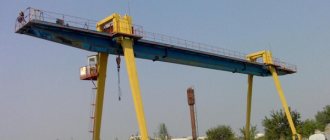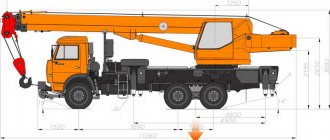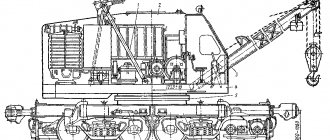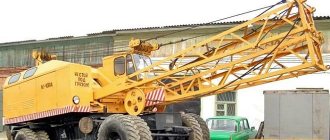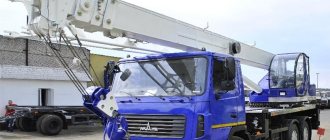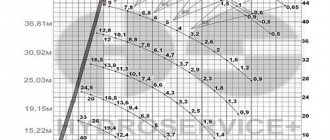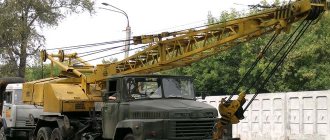Specifications
In various workshops and warehouses, a stacker crane is used for moving, loading and unloading, the distinctive design feature of which is a vertical column. Its characteristics are regulated by GOST 16553-88 and are in the following range of values:
- Load capacity 0.2-12.5 t.
- Load lifting height 2.5-32 m.
- The crane travel speed is 0.4-3.2 m/s.
- Width 1.2-2.8 m.
- Load lifting speed 0.125-0.32 m/s.
- Column type – solid or telescopic.
- Column rotation speed 9 rpm.
- Manual, semi-automatic and automatic control.
GOST 16553-88 Stackers
1 file 329.29 KB
Parameters may vary depending on the type of crane and the type of load it is used for. The most popular are forklifts with a lifting capacity of up to 1 ton.
Two ways to support a crane runway
An I-beam span has upper and lower horizontal chords. Supporting ones are placed on the upper one, and hanging ones are attached under the lower one:
- Support - mounted with wheels on the rails from above. The load-bearing capacity of the support GPM is maximum (up to 500t), but the construction of a crane trestle or supports requires financial costs.
- Suspended - hooked to the lower shelves of the crane runway.
This type of support is easy to install and has a low cost. The small lifting capacity (up to 8 tons) is compensated by the low height of the structure, which is why the size of the working area is larger than that of support cranes. Suspended cranes can be installed on part of the workshop. It is possible to dock cranes (butt lock) and move trolleys from one crane to another.
Device designs vary. They can move translationally or make revolutions around the vertical axis (chordates, radials and rotations) of the PMG.
Device
The design of a stacker crane may vary depending on the scope of its application, the type of product, as well as the room in which it is installed. Regardless of the type of construction, stacker cranes have a common structure:
- Movement mechanism;
- cargo trolley;
- rotating platform;
- Column;
- gripping mechanism.
To ensure the safety of workers and protect equipment from possible overloads, each stacker is equipped with:
- Emergency brake;
- speed limiters;
- emergency switch;
- cable tension control device;
Additionally, stacker cranes with cabins are equipped with seat belts, cabin catchers and an operator occupancy detection device (for semi-open type cabins).
Faucet protection panel
The protection panel on crane equipment is used when controlled using a controller. Visually, this is a cabinet with equipment inside. The cabinet can be locked either with a regular lock or with an electric switch. That is, if the crane mechanism is connected to the mains, you will not be able to open the cabinet.
The panels are used to protect cranes with 3 to 6 electric motors. For alternating current of 220, 380 and 500 V, panels of the “PZKB” type are used, for direct current of 220 and 440 V - of the “PPZKB” type.
The protective panel includes the following devices:
- Maximum – protection against overload and electrical circuit short-circuit.
- Zero – prevents random startup after problems with power supply.
- End stops – activates dead-end stops at the edges of rail tracks.
Rice. 2. Protective panel diagram
For the circuit in Figure 2, the protective effect on the circuit is provided using contact relays. The breaking contacts are connected in series to the linear contactor coil, and the relay coil is connected to the power circuit of the electric motor. (All relay coils are designated KF).
Important TOP 3 bulldozers John Deere by technical characteristics
When the current in the circuit exceeds, the relay contacts open and the electrical equipment is disconnected from the external power grid. This saves the crane motor and wiring.
Classification
By design, stacker cranes are divided into rack and bridge cranes, and can also be designed for extended and normal loads.
According to the type of load-handling devices, stackers are classified into:
- Fork;
- pin;
- magnetic;
- platforms.
Most often, a fork the size of a standard pallet is used; other types are used for specific loads. To work with long loads, telescopic grips are used, which can also work with normal loads.
Shelving
Rack-type stacker cranes move between two racks along a rail track laid on the floor. To ensure stability, the upper part of the column is mounted on guides, which in turn are attached to the racks.
Advantages of rack type stackers:
- high speed of movement from 1.5 m/s to 3.5 m/s;
- the speed of the gripping device is 0.1-0.65 m/s
- load capacity varies from 150 to 1200 kg;
- the working height (lifting the load-handling element) reaches 32 m.
Due to limited work space, multiple stackers are often required, increasing purchase and maintenance costs during operation. Excellent for warehouses with a small amount of cargo and high turnover.
Pavements
An overhead overhead stacker crane has a single or double girder bridge to which a trolley with an installed column is attached. A carriage with a load-handling member is attached to the column. The entire structure is mounted on a crane runway, which can be mounted on special supports, building floors or directly on racks.
Advantages of an overhead stacker crane:
- Maintenance of the entire warehouse area;
- no requirements for flooring;
- use of narrower passages;
Overhead stacker cranes are effective for warehouses with low turnover and large quantities of cargo. Due to the ability to work over a large area, they allow you to save on the use of additional lifting equipment.
Crane design
Overhead cranes are cranes whose design consists of two guides and a beam connecting them, which in appearance resembles a bridge. A lifting mechanism is installed on the beam. The beam moves along guide platforms using special trolleys. In this way, an overhead crane can move a load across the entire area of a rectangular room.
- Double-girder bridge with rail
- Cargo trolley
- End beam assembly
- Control cabin
- Gallery
- Geared motor with brake
- Conductor system of garland type
- Cable channels for conductors
- Main cabinet with converter
- Email cargo trolley cabinet
- Rod for fastening the crane current collector
- Rotary speed selector
- Crane stop buffer
- Troll service cabin
- Cable breaker
- Hatch to enter the gallery
- Trolley stops
- Telpher stationary
Stacker control
The stacker crane can be controlled:
- From the cockpit;
- from the floor;
- automatically.
Control from the floor is carried out using a remote control, which is equipped with: control handles for the bridge and trolley drives, emergency shutdown buttons for equipment and crane lighting.
The cabin is equipped with safety features and comfort for the operator: armrests, seat belt, latches or lock on the door and control panel.
Automatic control is carried out using a computer, which saves time and human resources. The efficiency of automated systems is 20% higher than that of standard models, but they are not widely used in Russia.
The use of stacker cranes allows you to mechanize or automate a warehouse, increase work efficiency and reduce the number of errors caused by the “human factor”.
Additional features of double girder overhead cranes
Frequency converters of double girder cranes ensure slow, uniform and safe movement of lifted loads, reducing sway and vibration during operation of the equipment. The presence of a collision avoidance system allows you to work simultaneously with several cranes on the same track. Another advantage of devices of this type is the availability of additional equipment for easier access to working parts and elements in production (lighting, pipelines, electrical, ventilation, etc.).
You can order the design and production of double girder cranes in both general industrial and special versions from our company.
Main components and mechanisms of lifting machines
Drums
() are used for winding steel rope. To ensure that the rope is wound evenly, spiral grooves of a semicircular cross-section are made on the drum.
Figure 24 – Drum
The rope capacity of the drum must be such that in the lower position of the load-handling element on the drum, at least one and a half turns of the rope remain wound, not counting the turns located under the clamping device.
The drum is rejected if it has cracks of any size, or wear of the grooves along the profile is more than 2 mm.
Block
() - a disc-shaped part with a groove around the circumference for placing a rope. The blocks serve to guide the rope. The blocks must have a device that prevents the rope from leaving the block stream.
Figure 25 – Block
Blocks are rejected if the wear of the strand is more than 40% of the original radius of the strand. It is strictly prohibited to operate a block with a chipped flange, since a chipped flange can cause the rope to come off the block and sometimes cause the rope to be cut.
Pulley hoist
– a lifting device consisting of movable and stationary block cages, through the blocks of which ropes are passed.
The number of branches of the rope into which the weight of the load is distributed is called the pulley multiplicity
. The factor indicates how many times the force applied to the rope is reduced.
Cargo Hooks and Loops
– universal load-handling organs. According to their shape, cargo hooks are divided into: single-horned and double-horned, and according to the manufacturing method: forged (stamped) and plate. Hooks for loads exceeding 3 tons must be manufactured rotating on closed ball bearings. Safety locks are installed on cargo hooks when removable load-handling devices may spontaneously fall out of the hook mouth.
Crane operation is not allowed if the hook has the following malfunctions:
- cracks and tears on the surface of the hook;
- the hook does not rotate;
- the safety lock is missing or faulty;
- the hook is unbent;
- the wear of the throat is more than 10% of the original height of the working section.
Welding or sealing of hook defects is prohibited.
Sometimes, instead of cargo hooks, solid forged and detachable cargo loops are used. With equal load capacity, the loop has smaller dimensions and weight compared to the hook, but the loops are less convenient to use.
Hook suspension
() consists of two side cheeks, blocks, a traverse and a hook. The hook traverse is installed in the side cheeks and is secured against axial movement by two locking bars. During prolonged operation, the nut that is screwed onto the thread of the hook when securing it in the hook cage may loosen or come loose.
Figure 26 – Hook suspension
To prevent this, it is reinforced with a locking strip. Locking the nut using pins or cotter pins is not allowed.
What lifting machines does the slinger service?
Lifting machines serviced by slingers include pipe-laying cranes, loader cranes, and load-lifting cranes.
Pipe laying crane
() is a self-propelled lifting machine with a side boom for lifting, transporting and installing pipes. The base machine for a pipe-laying crane is usually a crawler tractor.
Figure 1 – Pipe-laying crane
Crane arm
() is a lifting machine consisting of a crane mounted on a vehicle or foundation.
Figure 2 – Loader crane
Loader cranes are designed for loading and unloading operations, loading and unloading the vehicle on which they are installed. They fold compactly for transport, are lightweight and can be mounted on almost all trucks. The mass of the manipulator, as a rule, does not exceed 20-25% of the payload capacity of the base vehicle, which ensures the effective use of the vehicle for its intended purpose - for transporting goods. Possessing high maneuverability and precision movements, a vehicle equipped with a crane-manipulator simplifies the process of loading and unloading operations.
General rules for installing spans
- The spans of overhead cranes must be connected with the spans of buildings;
- If the width of the bridge crane span does not exceed the length of 23 meters, then only one path is laid;
- Span cranes must have their own gradation, which must be created in accordance with the standards.
Standards for grading overhead cranes were created in order to establish the interchangeability of cranes. This is very necessary for industrial plants that use cranes. Sometimes in production it is necessary to change the crane span. To do this, you need to know that if the crane span is increased, then this crane will be able to lift loads much lighter than those that it lifted before increasing the span.
But still, if there is a need to increase the span of the crane, but leave the load capacity the same, then it is necessary to carry out special calculations, which are carried out when installing the metal structure. If the span is reduced, the ability to lift loads will remain the same as before the span was reduced. Of course, such work can only be entrusted to professionals and workers who have extensive experience in carrying out such work. Since such work must be carried out in accordance with standards.
Application
This technique is mainly intended for lifting and lowering loads. Lifting forks are designed for various types of pallets. There are models with adjustable fork spacing.
A stacker is an indispensable mechanism in a warehouse for raising/lowering loads on movable forks and moving them over short distances. At a relatively low price, stackers are capable of providing significant volumes of transported cargo and are very functional, and also do not require special training or a license.
Where warehouse space is used vertically, but the business is limited by budget, small hydraulic stackers are especially often used. They make it easier to handle pallets in small warehouses and small shops. All-electric stackers - electric stackers - are significantly more productive. If the stacker is self-propelled (with a specially equipped operator’s seat), then its speed increases to 8-10 km/h. Such stackers have a large lifting height (up to 4-6 meters) and can work up to two shifts without recharging. High-rise stackers have the ability to lift loads to a height of up to 12 meters, with a very small distance between the racks - up to 2.6 meters. High-rise stackers have a high load capacity - up to 2.5 tons, as well as high speed - up to 10 km/h.
Stackers are essential equipment for any warehouse where cargo is stored on pallets. Currently, there are many types and models of warehouse equipment on the lifting equipment market: manual hydraulic stackers, self-propelled driven stackers, electric stackers, reach trucks. Each type of lifting warehouse equipment is designed for specific operating conditions. Using a stacker in a warehouse is only possible if the floors are of high quality.
Stackers are used to perform intra-warehouse work on transporting and stacking cargo pallets. All types of stackers can be divided into three groups: manual hydraulic stackers; self-propelled driven stackers; electric stackers.
The main parameters taken into account when choosing stackers are:
- The turning radius (Wa) affects the width of the working aisle in which the equipment must work.
- Working aisle width (AST). The parameter is indicated taking into account work with a pallet 800*1200 along the forks, or with a pallet 1000x1200 across the forks. Determines the minimum space required for work and load handling. Measured in mm. That is, with AST = 3000 mm, the equipment can operate with a passage width of 3 meters or more, although Wa can be 2000 mm.
- Residual lifting capacity - due to the design features, the lifting capacity of the stacker decreases with the height of the mast. Therefore, when choosing a stacker, they usually focus on the maximum weight of the load at the maximum height.
- Battery type and capacity - there are two main types: alkaline (currently practically not used) and acid. Acid ones, in turn, are divided into starter (as in passenger cars) and traction (from 100 Ah). The battery capacity affects the operating time - the larger the capacity, the longer the equipment will work; and on the residual lifting capacity (other things being equal, a pump with a more powerful battery can create greater operating pressure in the lifting hydraulic system).
In addition, in various situations, important parameters may be: the construction height of the stacker (height “in the light”), the width of the carriage (for a Euro pallet or an industrial pallet), vertical lifting speed, horizontal speed, method of replacing batteries, etc.
MIG company
Specifications
- Load capacity – 160 kg.
- Crane travel speed – 80 m/min
- Carriage movement speed (lifting) – 12 m/min
- Lifting height (along the cabin platform) – 6835 mm
- Path length – 25 m.
- Control from the cockpit via joystick.
Rack stacker crane for picking from racks.
The stacker crane is used to place goods in the cells of the rack and pick orders from the operator’s cabin
Stroy-Tekhnika.ru
Construction machines and equipment, reference book
Purpose and scope of cranes
TO
category:
Enterprise cranes
—
Purpose and scope of cranes
Load-lifting machines (HLM) are designed for lifting and moving loads over short distances in the space limited by the area of the industrial enterprise served by the machine. Obviously, the main mechanism of the PMG is the load lifting mechanism, from which it gets its name. In modern production, various hydraulic and hydraulic machines are widely used, but lifting cranes are the most widespread.
A load-lifting crane is a cyclic lifting machine designed to lift and move loads (held by a load-handling member) from one point on the site served by the machine to another.
The cycle of work consists of grabbing (slinging) the load, lifting it to the required height, moving it to the desired point of the service area, lowering, unslinging the load and returning the crane to its original position.
—
A load-lifting crane operates briefly, in a repeating cyclic mode, in contrast to continuous (permanent) machines, such as conveyors. A lifting crane is the main means of mechanizing production processes, loading and unloading, transport and warehouse operations at all industrial enterprises, construction and installation sites, river and sea ports, railway transport and other sectors of the national economy.
It is obvious that the scope of application of load-lifting cranes is very extensive. Various types of cranes are used: overhead, gantry, cantilever cranes and stacker cranes.
Criterias of choice
To choose the right stacker, you need to consider:
Initial and final load capacity. The weight that the stacker can support at the beginning of the lift and at height is different. For example, equipment can lift 1 ton, but at maximum height it will only hold a load weighing 500 kg. Performance. A complex quantity that is measured in pallets per hour. The calculation takes into account the speed of movement, the duration of continuous work, and the speed of raising the forks. Fork width This parameter must correspond to the size of the pallets. Lifting height. This criterion determines the height of the mast and the stability of the stacker. Complexity of mechanism and control. These parameters can be either directly or inversely dependent. Sometimes ease of control is achieved at the expense of more complex technical components, and this significantly increases the cost of repairs in the event of a breakdown. Coverage requirements
It is necessary to pay attention to the movement system, the quality of the wheels and their reliability. The stacker should move smoothly, not tilt or roll away.
The stacker significantly speeds up and facilitates the work of unloading and loading cargo. In large logistics centers such equipment will become an indispensable assistant.
Possible breakdowns of warehouse equipment
Like any other equipment, stackers also require timely repairs and maintenance. Of course, the absence of an internal combustion engine significantly increases service life and reduces repair costs. However, in any case, moving parts are subject to wear, so from time to time you will have to replace consumables (bearings, wheels, etc.), as well as maintain electric motors (timely lubricate and check the windings of the excitation coils).
The most common breakdowns include:
| Symptoms | Breaking |
| Difficult movement of the trolley | 1. The first reason is wear of the wheel bearings. In this case, replacement is required. 2. Wear on the motor shaft - the bearing is also checked. |
| Forks do not rise and fall | 1. The oil level in the hydraulic system is too low (for electro-hydraulic models). There may be an oil leak or valve failure. 2. Problems with the electronic part of the electric lift - diagnose the electric motor. |
| The forks start working with a delay | 1. In electrohydraulic models, this in the vast majority of cases means the presence of air in the hydraulic system. 2. Possible problems with the electric drive control unit. |
| Cart sparks when touched | A common problem is when electricity penetrates the body of the stacker. As a rule, the problem lies in the fact that the insulation layer in the motor windings is damaged. But this is not the only reason. Perhaps one of the wires has become exposed and is shorting to the housing. In any case, it is necessary to diagnose all electrical components |
It is also important to understand that electric stackers are powered by rechargeable batteries, which have their own service life. Over time, the capacity of the batteries decreases, which means that you will have to charge the car more often, and the full charge will be used up faster
Typically, the battery life is about eight years. Therefore, from time to time you will have to change the used battery.


